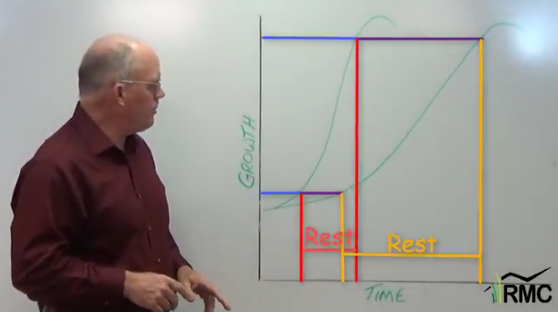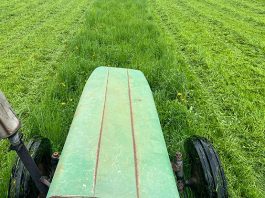
I cannot believe the weather. I have never seen a spring quite like this. After a long discussion recently with an old friend who is 79, he said he hadn’t either and we both agreed that we would rather not see another, but only because the weather didn’t repeat itself. We have gone from soggy wet pastures with forages that were hesitating to grow to runaway forage on wet or saturated soils.
I’m still an advocate for utilizing grazing first as the main means of forage management. The normal recommendation is to continue moving animals through the system until the first pasture or allotment is ready to be grazed again. Then go back to that first field and start over. The fields that are skipped can be used as summer stockpile as is, clipped to remove seed heads, or mowed for hay.
I want to discuss these choices, but first I encourage you to do a simple assessment.
On average, by early to mid-June, most cool season forages have reached about two-thirds of their dry matter yield. Stop and think about that for a moment. By this point, most cool season grasses have gone from leaves only, to pollinating, to seed production. Removal of vegetation by grazing has slowed the process down some, but it won’t stop it.
What you need to assess, is how much forage you have presently. You should not be able to completely control all forages by grazing this time of year. Consider this. If two-thirds of the potential forage that you can normally grow on the farm has now been grown, there had better be more forage out there than what you need for the time frame. If the cows are keeping up with the forages, then you either don’t have enough forage or more likely, you have too many cows.
It would be nice if forages grew at approximately the same rate as consumption. There are times when this is possible, but it will not stay that way long. Pastures can be managed by what I call “put and take” grazing, which is actually more like a continuous grazed system, than a rotated system. Animals are added or removed to keep consumption more in balance with forage growth. This method is not very practical. This method, if workable at all, is probably best done with stocker cattle because their numbers might be slightly easier to adjust, as needed. If you have a cow-calf operation, it will not work.

Continuing with our discussion on making an assessment, do you have excess forage right now in early June? If yes, then good, animal numbers are at least somewhat in balance with forages long-term. If no, then forages will be even shorter in supply as the year progresses, reducing the number of grazing days and increasing the number of feeding days. The more “feeding” days, the more out-of-pocket expense in the cost of operation.
Our cool season forages grow with good soil moisture and moderate temperatures, but will slow down drastically or stop growth in response to low soil moisture and high temperatures later in the summer. That’s why you need to stockpile some growth for later. You also want to go into summer with as much vegetative forage and cover as possible because that live vegetative cover helps to keep the soil cooler and slow evaporation (although it certainly is not an issue right now), which helps promote at least some continued growth.
Grazing, especially when you graze just the top portion of the plant, helps to promote more growth, more tillering of grasses, as long as moisture is present and summer heat has not slowed the process down too much.
Now getting back to the original discussion about your options: fields that are skipped can be used as summer stockpile as is, clipped to remove seed heads, or mowed for hay.
Stockpiled Pastures
If you skip the fields and stockpile them and do nothing else, the forages will mature. Mature forages are usually lower in protein and higher in carbon. There is still some good feed value in this forage, but animals will tend to eat the best and leave the rest. If the field could use some extra soil organic matter or benefit from extra rest, then this would be a very good choice. When you finally get through those earlier paddocks the second time and find that the first-grazed field is not ready to be grazed again, then you could go back to the skipped stockpiled field. It is best to either strip-graze or allocate out in sections to maintain some quality as you move across the field. While the livestock are grazing this summer’s stockpile, the rest of the pastures are resting and recovering the best they can for later use.

There is some value in clipping or topping that summer stockpile with a rotatory mower, but timing is important. It needs to be done early enough to help promote some continued growth. Once the seed heads start drying off, you are mainly only making the plants look better cosmetically. New growth is harder to achieve at this stage, especially as drier, hotter days increase. Clipping must be done while the seed stalks are still green and before the plants are too big.
It is almost impossible to mow high enough to only remove seed heads and not remove too much leaf. Mowing too short will remove potential feed and the better part of the solar panel or cover it up with the clippings. After it is clipped, stems and cut forage is often coarser and in some cases may be less desirable to the animal. I’ve seen this go both ways. Again timing is everything. The more vegetative the field is when clipped the better. There is a cost to clipping, so the added value of forage, potential extra regrowth, or weed control needs to be obtained to justify the expense. Most pastures I’ve been in so far this year that have good fertility and have not been grazed yet, are too dense and tall to clip, so you would lose more than you would ever gain. You would be better off just grazing it as discussed earlier, or my least favorite option—haying it.
Making Hay
 If you are in what I refer to as the “building” stage of soil fertility – in other words, it still needs some – then you would be better off bringing in sources of fertility, such as hay, then to remove it. Hay harvested off a pasture will be removing nutrients from where they are needed and moving them to a “feeding” area where they are already high. When grazed, most nutrients that are present have a higher chance of remaining and being used for future forage growth.
If you are in what I refer to as the “building” stage of soil fertility – in other words, it still needs some – then you would be better off bringing in sources of fertility, such as hay, then to remove it. Hay harvested off a pasture will be removing nutrients from where they are needed and moving them to a “feeding” area where they are already high. When grazed, most nutrients that are present have a higher chance of remaining and being used for future forage growth.
Fields that you cannot graze for one reason or another, would be better choices for hay or fields where nutrients, especially phosphorus might be high from past heavy applications of manure. If a pasture is cut for hay, restore fertility back to that field as soon as possible to help promote and sustain the forage. Understand that those fields will take longer to recover than if they were grazed, especially as the days get hotter, and perhaps drier.
Keep on grazing!
Reminders & Opportunities
During hot and drier weather in July and August, warm-season forages grow quite well and are better suited while the cool-season forages usually take a vacation. Don’t miss a chance to learn more about them later this month (information below).
• Using Native Warm-Season Grasses in a Grazing System – Agency In-Service Day – June 20th, 2019. Producer/Landowner Day – June 21st, 2019, Southern Indiana Purdue Ag Center. No registration fee, but registration required by June 7th. RSVP to jhodge34@utk.edu.
• Grazing 102 – June 21-22, 2019, Southern Indiana Purdue Ag Center. Grazing 102 is a program designed to help producers understand important concepts needed to make a management-intensive grazing program work for their own operation. Contact Jason Tower at towerj@purdue.edu or 812-678-4427.
More pasture information and past issues of Grazing Bites are available here.




